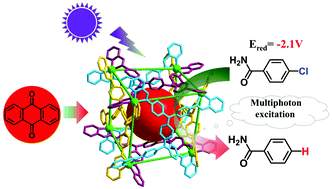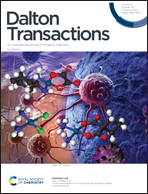Encapsulating electron-deficient dyes into metal–organic capsules to achieve high reduction potentials†
Abstract
The design of artificial supramolecular systems that mimic the structure and functionality of natural enzymes to achieve efficient chemical conversions is a promising subject. In this work, we assembled a novel metal–organic capsule from electron-rich dyes, polyaniline compounds, as ligands by a subcomponent self-assembly strategy. By encapsulating electron-deficient dyes, anthraquinone or 9,10-dicyanoanthracene, into electron-rich pseudo-cubic capsules, we successfully constructed an artificial enzyme-mimicking supramolecular system for the efficient photocatalytic reduction of aryl chlorides with high reduction potentials (Ered < −2.0 V) via multiphoton excitation. Within the confined space of the host, the electron-deficient dyes were forced to come into contact intimately with the electron-rich host walls, which facilitates the photoinduced electron transfer process. Moreover, we achieved quantitative yields in the photocatalytic reduction reaction under mild conditions within 30 minutes, which was rarely reported in the previous literature in terms of reaction efficiency. This study provides a general and valuable strategy for activating inert substrates, which may have potential applications in solar energy conversion and enzyme-mimicking catalysis in the chemical industry.

- This article is part of the themed collection: Spotlight Collection: Metallocycles and Metallocages


 Please wait while we load your content...
Please wait while we load your content...